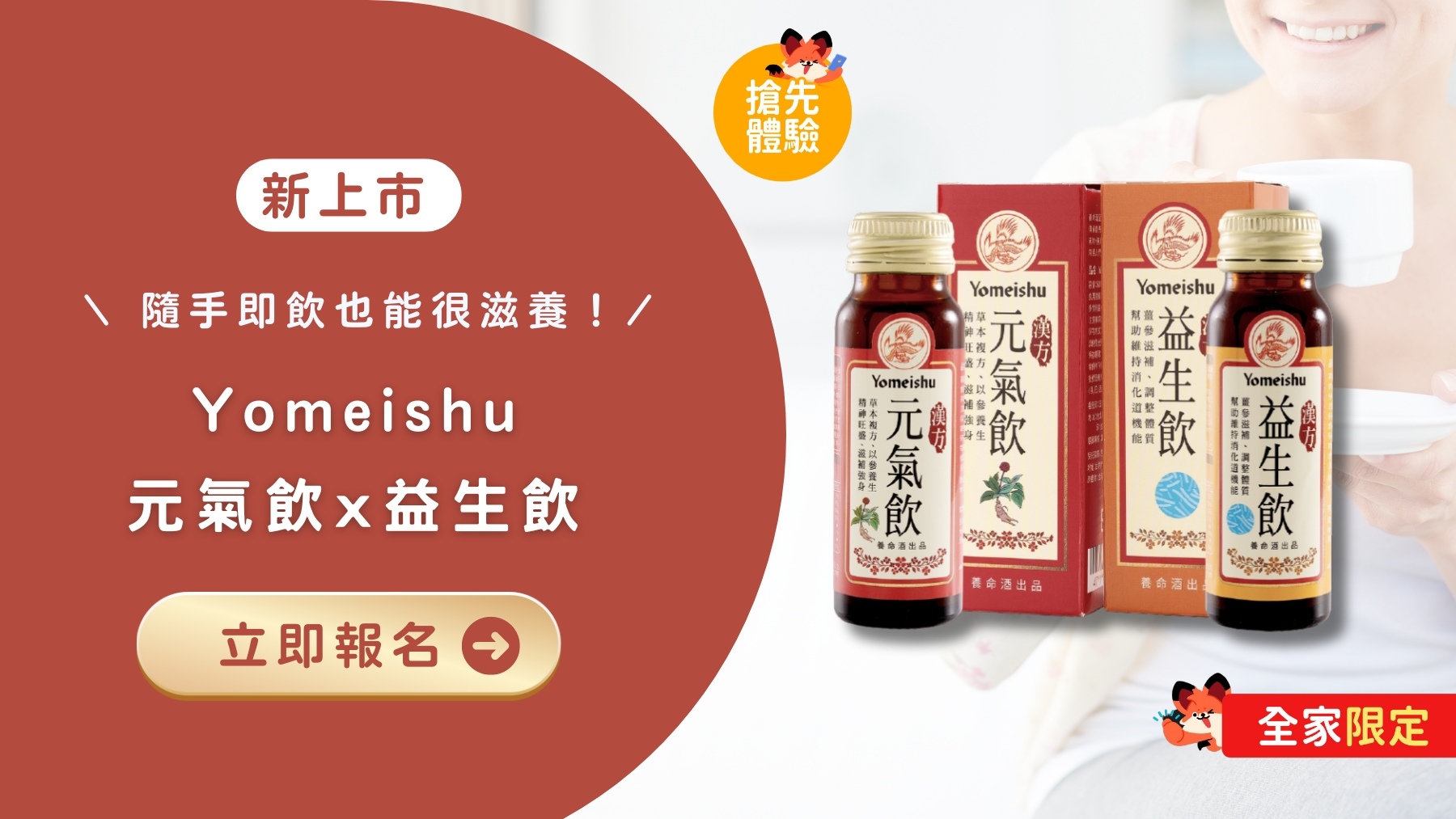Pseudo chemistry with decagonal tiling and six decagons coexisted without any defect
ABSTRACT
The six distinct decagons have been used to construct a cluster system and a polyatomic molecule, demonstrating that decagonal-style tiles can be extended to infinity and be defect free. It is the first time that all six decagons have been observed coexisting on a single tiling, with five-fold rotational symmetry, and the potential to continue being defect-free indefinitely.
Key words: Polyatomic molecule, decagon, defect free.
INTRODUCTION
The fat and thin rhombus with different acute angles of 36 and 72 can be regarded as two different atoms, each consisting of four equilateral valence bonds (Figure 1a). Two rhombic atoms can combine to form six different decagonal shapes (Figure 1b), which can be regarded as molecules here. The first three (or possibly the first two) of the six regular decagons make up the famous Penrose tile with five-fold symmetry, as illustrated in Figure 2. Traditionally, Penrose tiles are laid from two shapes of rhombuses (or kites and darts); this method is tedious and error-prone, and frequently results in incorrect alignment (Penrose, 1974). If the tiles were built specifically from polyatomic molecules made of 50 or more rhombuses, it would save a lot of time and increase the likelihood that the right decisions would be made when laying uninformed tiles (Levine and Steinhardt, 1986).
In this study, using the systematic concept of decagonal assemblies shown in Figure 3, a new method of Penrose tiling was developed, in which alarger-sized clusters of 50 or more decagonal molecules were employed to construct tiling (Figure 4). This indicates means that more than 500 diamond-shaped tiles can be laid in a single stretch, saving time and increasing the likelihood that the right decision will be made when laying uninformed tiles.
These decagonal based pseudo molecular are the fundamental building blocks of tiles. How to make various poly-atoms and some smaller clusters in order to build a tile that consists of all six decagons is shown hereafter (Socolar and Steinhardt, 1986; Steinhardt et al., 1998).

Figure 1. (a) The fat and thin rhombus; (b) All six different types of decagons made by to rhombic.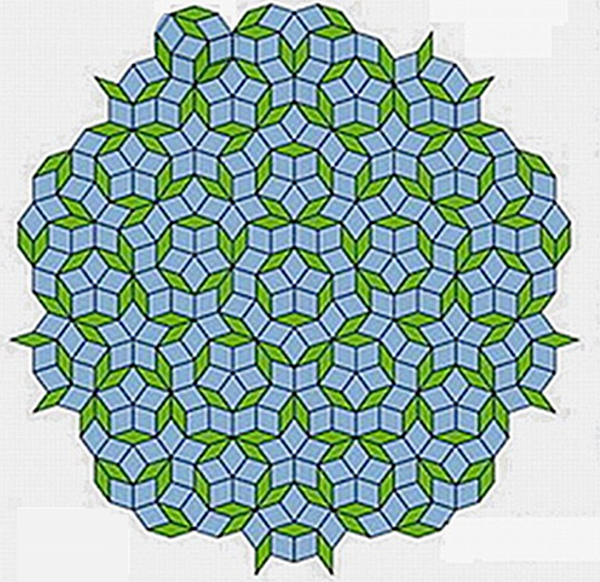 Figure 2. Original Penrose tiles.
Figure 2. Original Penrose tiles.
Figure 1 shows all six different types of decagons, (considered molecules), consisting of two rhombuses (considered atoms), with acute angles of 36 and 72 degrees. For the fat rhombus, the decagons of type-a, type-d, type-e and type-f are highlighted in red, pink, yellow, and light blue, respectively. Considering the decagons as molecules, these molecules may be coupled (reacted) together to form two atomic molecules, triatomic molecules, tetra-atomic molecules, penta-atomic molecules and hexa-atomic molecules. Figure 3 shows the coupling results of these imaginary reactions for bi-atom molecules of two different types: asymmetry and symmetry. The six molecules (decagons) in Figure 1a can be recombined in a symmetrical or asymmetrical manner to form more than hundreds of bi-atom molecules. They are labled as aa m-a, ab m-a, ac m-a and bb m-s, bd m-s and ccm-s, cf m-a, ee m-s, ef m-a, e.t.c., where a, b, c, d, e, f, are marked for six decagons in Figure 1a as a molecule, respectively and m-s and m-a marked as mirror symmetry and mirror-asymmetry, respectively. The diatomic molecules that cannot be further coupled and would later generate defects are specifically labeled with the dark gray diamond colour. Figure 3 shows just a few diatomic molecules that could be used as an example in the next tiling work to form smaller clusters of pentagonal or circular shape.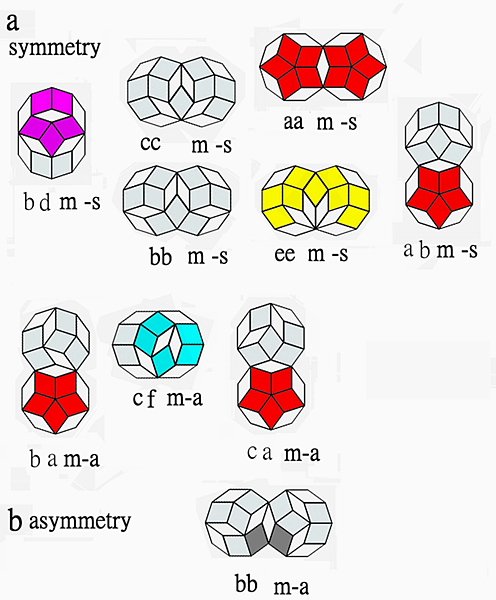 Figure 3. Different types of pseudo poly-decagonal molecules. (a) symmetric; (b) asymmetric.
Figure 3. Different types of pseudo poly-decagonal molecules. (a) symmetric; (b) asymmetric.
As shown in Figure 4a and b, bi-atomic molecules can be used to construct numerous minimal clusters with five-fold mirror symmetry. These are the smallest pentagonal-tile clusters that could later serve as a basis for developing into larger tiles through different coupling schemes. Different equilateral heterocenter (iso-edge-hetero-center) or isocenterheteroedge clusters can be produced. Five- fold- symmetry are tagged with 5-f-s, mirror symmetry are tagged with m-s, and mirror asymmetry are tagged with m-a. Only a few of the seed graphs that are helpful for a thorough understanding of this article are listed here.
Figure 4 shows different types of decagonal type cluster seeds which are the smallest pentagonal tile. The different types of seed clusters can be divided into two categories: Figure 4a shows different decagons surrounding couple with type-a decagon, and Figure 4b shows decagons self-surrounding couple. Seed labeling is a crucial and error-prone task because without accurate labeling, it is impossible to produce larger tiles that are defect-free. Take, for instance, the graph with the tag bbabb-a m-s. It represents four type-b and one type-a decagon that are coupled and surround type-a. This is not five-fold symmetry; rather, it is mirror symmetry. Five type-b decagons surrounding a type-a decagon are indicated by the tag bbbbb-a 5f m-s, which also indicate five-fold symmetry and mirror symmetry. The graph with the tag aseeeee= marks five type-e decagons self-surround coupling.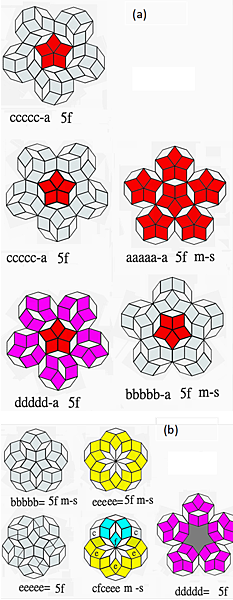
Figure 4. Different types of pentagonal shape seeds. (a) Different decagons surrounding couple with type-a decagon. (b) Decagons self-surrounding couple.
For ease of illustration, the symmetrical seed type bbbbb-a (5-f, m-s) in Figure 4 is selected as seed. All the seeds are considered as a smallest pentagonal cluster (shape). After the first round of surround coupling on the seeds, the second smallest pentagonal and circular decagonal tiles emerged as shown in Figure 5. When the five vertices of an a-type decagon are converted to b-type and aligned (inwardly), a new tile of the Penrose type is created, as shown in Figure 5d. This smaller typical Penrose tiles that can be self coupled to larger tiles. The result shown Figure 5b can be a self slant-shift coupling to infinity without generating any defects, and that by using a different method of coupling, a four-way symmetry tile can be constructed with a defect (of non-belonging decagons).
Returning to the article's main point, Figure 5c shows a pentagonal cluster consisting of only three different types of decagons (type-a, type-b, and type-d). Figure 6a shows the result after five times of surrounding self-coupling. There are some cluttered overlapping areas, and after modifying the cluttered areas, three new decagons of other types appear, as shown in Figure 6b. It clearly shows new tiles made of six decagons and three additional decagons. As a result, a tile, consisting of all six types of decagons, with quintuplet symmetry and no mirror symmetry, was created.
Summary
Different types of molecules consisting of two decagonal atoms were fabricated initially, and using these diatomic molecules, several pentagonal clusters with mirror-image and pentagonal symmetries were formed. One of them was chosen as a seed, and the four different decagonal clusters derived from this seed were found to be infinitely extendable without defects. The highlight of the study is the first observation that all six decagons coexist on a single tile, with five-fold rotational symmetry, and the possibility of going defect-free towards infinity.
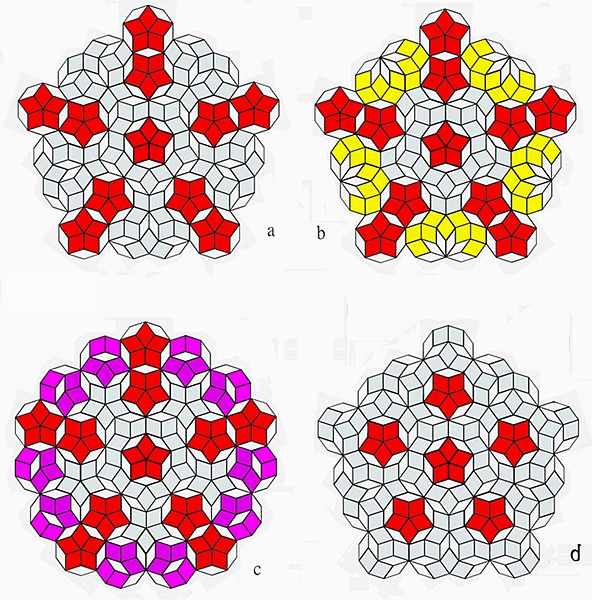
Figure 5. Four different unit of decagonal tiles for further coupling extension.
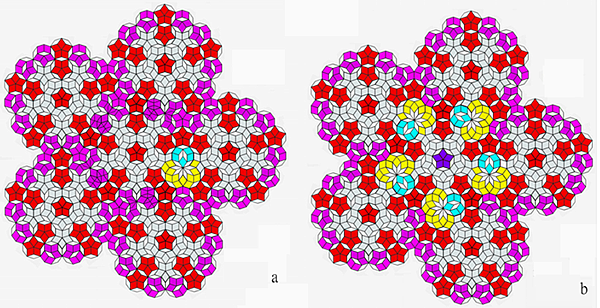
Figure 6. (a) The result after five times of surrounding self-coupling; (b) three new decagons of other types appear after modifying the cluttered areas.
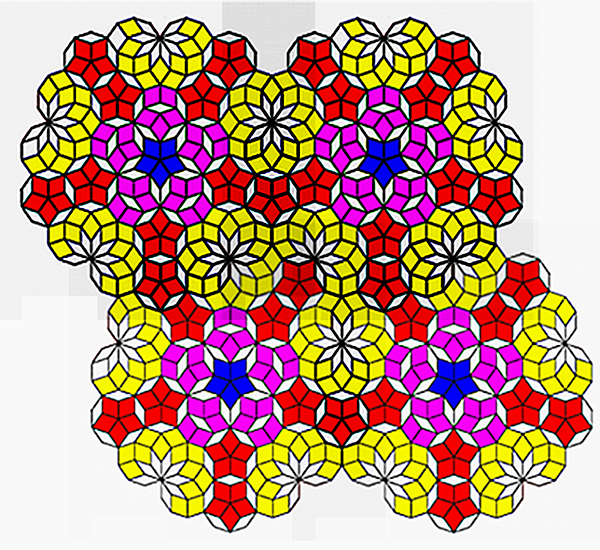
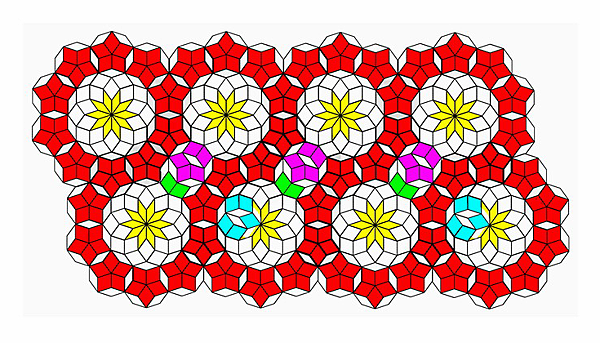
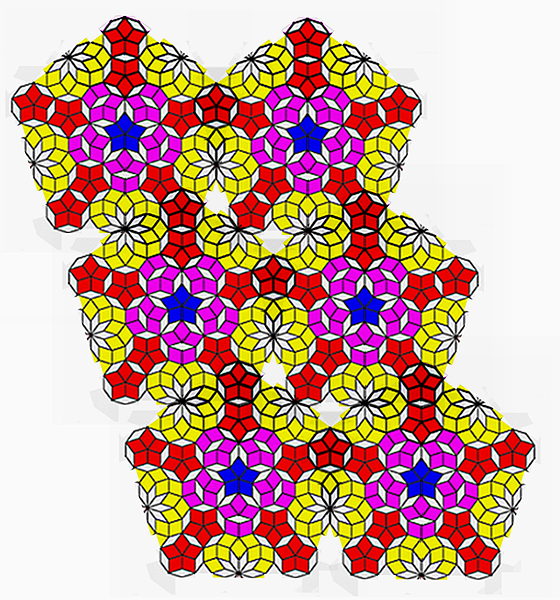
REFERENCES
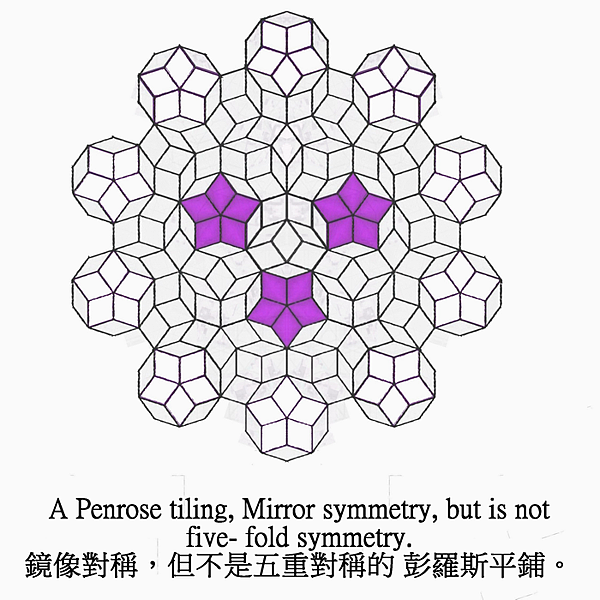
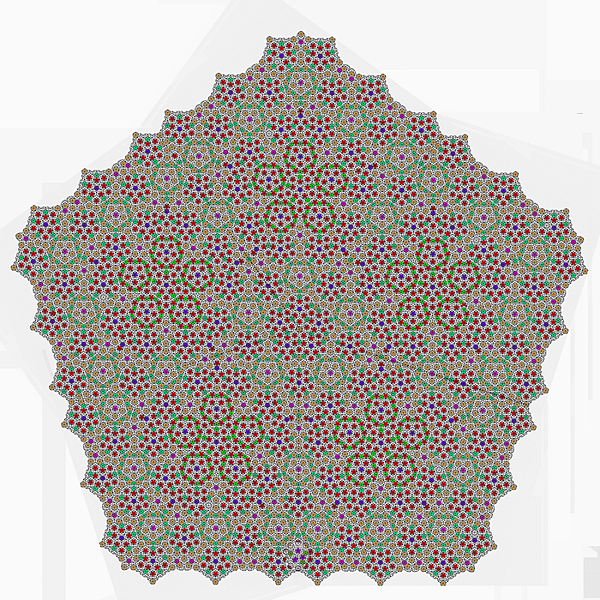
Penrose R (1974). The role of aesthetics in pure and applied mathematical research. Bulletin of the Institute of Mathematics and Its Applications, 10:266-271.
Levine D, Steinhardt PJ (1986). Quasicrystals.I definition and structure. Phys. Rev. B 34: 617596 – Published 15 July 1986.
Socolar JES, Steinhardt PJ (1986). Quasicrystals. II. Unit-cell configurations. Phys. Rev. B 34:617 – Published 15 July 1986.
Steinhardt P, Jeong H-C, Tsai A (1998). Experimental verification of the quasi-unit-cell model of quasicrystal structure. Published 5 November 1998
5 ) Kun CY. Unpublished


 留言列表
留言列表
